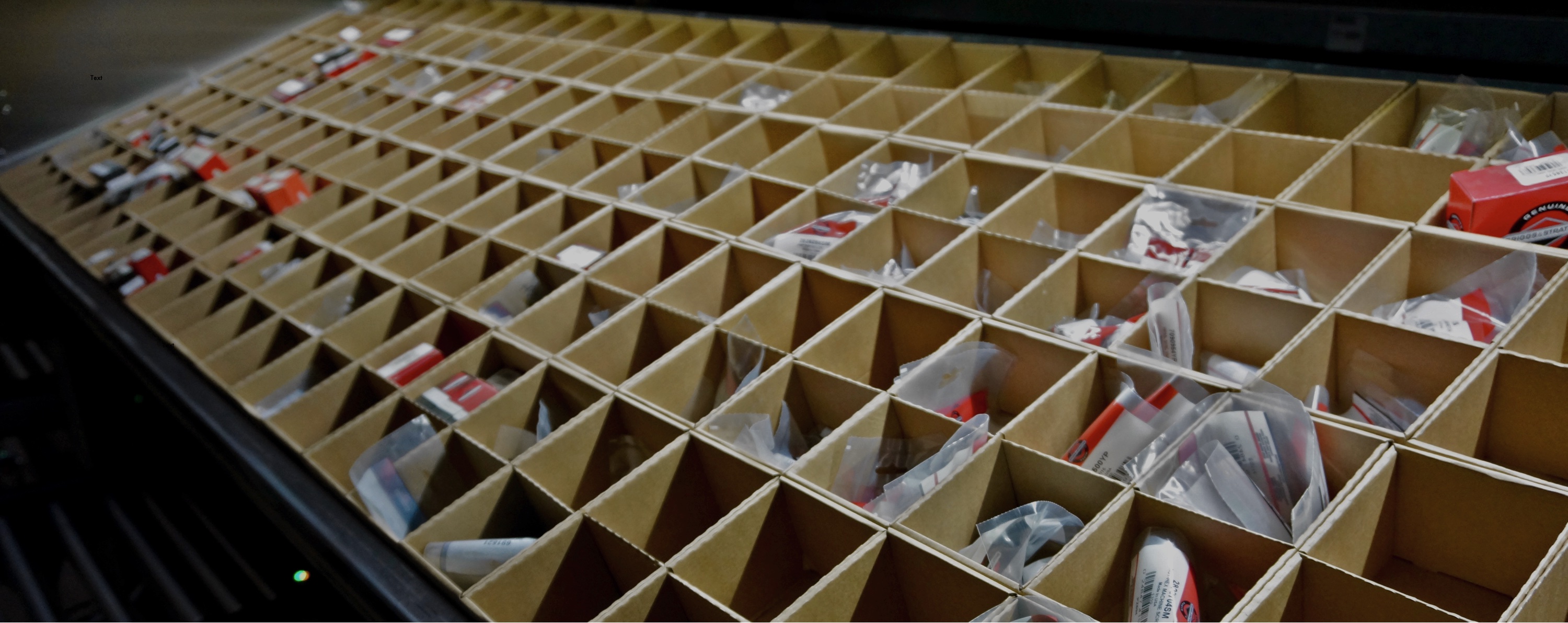SHARK WCS Pick List
Many ERP Systems have good functionality for goods reception, shipment and other inventory related functionality, but they are not build for all the challenges to build a highly effective warehouse.
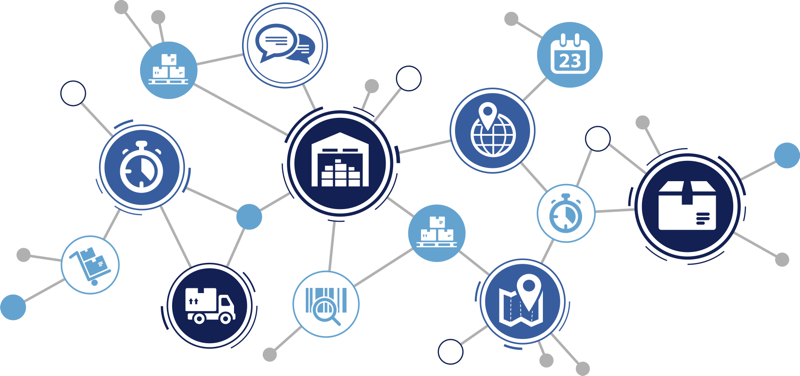
ERP Systems are good at many things - but not in the warehouse
It can be complicated to create and maintain location structures in shelving and automated storage, optimizing the picking sequence in the warehouse, control automation hardware and use the ERP software from a small PDA screen.
SHARK WCS fills that gab and provides a solution where the ERP System still is in control, but where SHARK takes care of the practical handling in the warehouse.
To help with this, SHARK WCS has an option, where the locations are created in SHARK. Note that this is only a way of maintaining the locations. What is actually stored on the locations, quantity and article numbers are fully controlled by the Host system. If it is more convenient to view the vertical lifts as a black box where the quantities and locations are fully maintained by SHARK, have a look at SHARK WMS - there is a solution available that will provide exactly that.
Send a simple pick list to SHARK WCS and it will perform the picking and controlling the warehouse automation hardware.
- Graphical pick list display.
- The host controls the inventory and locations.
- Graphical editor for creating locations in vertical lift trays.
- Graphical display of the picking locations.
- Integrated support for pointers and light bar in vertical lifts.
- Picking sequence maintained by SHARK WCS to minimize the walking distance and optimize speed.
- Optional location management in SHARK.
Order Management
The Host system send orders to SHARK WCS, basic information is:
- Order Number
- Order Type
- Orders lines with minimum article number, quantity and location.
Confirmation is send back when either the complete order or order line is finalized.
Host Integration
External ERP and other Host Systems can be interfaced by a REST API or by file exchange using shared folders or FTP. The standard files are XML.
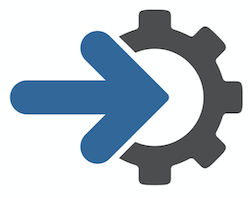
REST API: SHARK WCS has a built-in web server that publish a REST API for tight integration.
XML Files: Orders and acknowledge information can be exchanged using XML file format. The actually XML format can be modified by means of XSLT.
Groovy Scripting: Customized interfaces can be build using Groovy scripting.
Locations
Locations can be created in SHARK WCS, but it is not a requirement. The advance of creating the locations in SHARK, is that it has powerful tools for defining location layout, especially in vertical lifts. The locations can be created in SHARK and the exported to the Host.
Location naming: max 7 levels. The structure is defined and SHARK generates the location addresses by naming rules. This ensure consistent location addresses and system knowledge about the layout.
- Zone name - automat - tray - location on tray (row, col).
- Zone name - aisle - section - shelf - location on shelf (row, col) Formatting rules can be defined to set the exact location address format. Example: A3-15-D3 (Zone A, Automat 3, tray 15, location in tray: D3).
Layout editor: A graphical configuration tool makes it easy to define the warehouse layout.
Tray layout (automats): Default tray types are created using a graphical editor. This makes it easy to create even complex layouts. This is later used when picking, to show a graphical view of the tray for the operator. Also used for controlling pick-by-light systems in automats.
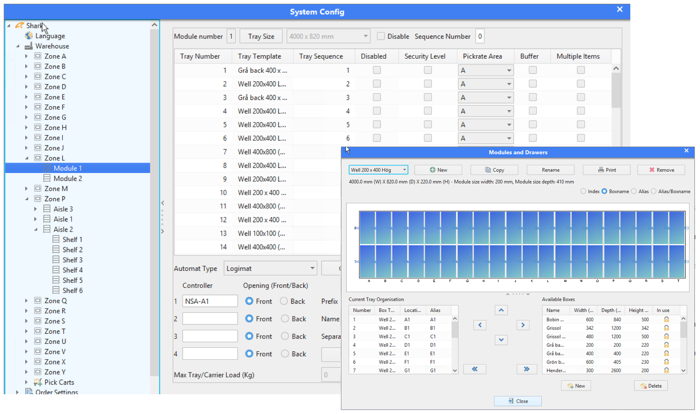 Configuration of locations with a graphical editor for tray layouts.
Configuration of locations with a graphical editor for tray layouts.
Transaction Log
All transactions and operations that influence the stock are logged in the transaction log.
Sorting: The log is shown in chronological order, last on top.
Searching: It is possibly to search in time intervals, for a specific article number, order number, location, transport box or by operator name.
Filter: See only one order, article or location.
Transaction types logged: All (pick, store, adjust in various types).
Export: The log may be exported in an Excel or text file.
Language
SHARK support different languages.
Languages: English, Czech, German, French, Spanish, Danish, Norwegian, Polish, Russian, Swedish, Spanish.
Changing language: The language can be changed in the configuration. The program must be restarted after language is changed to make effective.
Mixed languages: Yes, individual languages can be set for each PC or PDA.
Order Pick and Put-away
Picking and storing goods by orders.
Batch picking: Batch picking is supported where several orders are picked in parallel. The batch is floating, meaning that new orders can be added and removed at any time. This ensures when using automats, that the batch may contains a suitable number of lines for optimal speed.
Sequence Optimization (Automats): The pick lines are sorted for optimal picking speed. For automats, picks from the same tray is picked together, then to minimize waiting time, automats are selected in sequence depending on when the trays are present in th opening. The location sequence can be set independent of the location address, set by a sequence number.
Sequence Optimization (Shelving): The location sequence can be set independently of the location address by setting a sequence number.
Confirmation: The selected method for pick and store confirmation can be selected freely. Supported are (one or more): by the enter key, article number, location code, order number, transport box number, confirmation button on automats. Different configurations for pick and store in automats and in shelving.
Batch put-away: Articles can be stored batched in a job with similar advantages as with batch picking.
Put-away Orders: A put-away order is used to define what to store. The order can be imported from an Host system by SHARK Link.
Labels: A label can be printed either automatically or on demand at pick or put-away. The layout and content of the label can be customized.
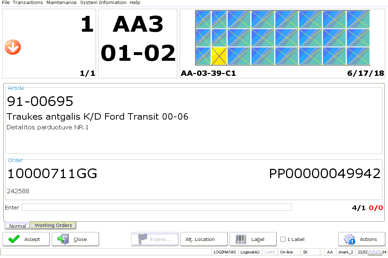
Example: Pick 1 pcs from the automat AA3 to trolley 01, position 02.
Pick Carts
Integrated support for pick carts (trolleys). A pick cart is typical a standard trolley with a number of positions, each with a box, but it can also be a pallet on a truck or similar methods of batching (grouping) orders used to move the goods around in the warehouse.
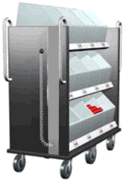
Number of pick carts: Unlimited.
Number of positions on the pick cart: Unlimited.
Boxes: Each position may contain one or more boxes. Each box contains one order. An order may be picked in one or more boxes.
Assignment of orders to a pick cart: Automatically based on order priority and release state. Manually selected by the operator. Filter function for order type (only one order type, on one trolley).
Pick-by-light: Smart pick carts with pick-by-light functionality are supported. SHARK controls light indicators on the pick carts and confirmation is done using a push button. Thereby barcode scanning can be avoided.
Host controlled: The host may specify a pick-cart position allowing import of pick carts, created in an external system.
Host Confirmation: The confirmation back to the Host system may contain box, and pick cart information in case the cart has to be processed in another system.
User Management
Authentication: Users must logon to the system by user name and password (empty password supported for simple logon).
Authentication Levels: Operator, Administrator, System.
Login with Barcode: The system may print a special barcode, supporting fast login without password. The barcode allows immediate user change without leaving the current function or previous logout (PC clients only).
Login with Cards: By connecting a USB Card Reader, a standard card can be used for login on PCs. The card can be “recorded” in SHARK to recognize it later.
Customization
Customization’s like special functionality, reports, etc. can be made on request. Fully customized software is also possible, Groovy scripting is supported in certain areas.
Barcode Equipment
Most installations use barcodes.
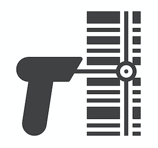
Label Printers
The system is delivered with a standard set of labels that can be configured.
Printer types: Most label printers are supported for printing barcodes, order labels, pick labels, etc. SHARK is delivered with predefined labels written in the ZPL language for Zebra label printers and compatibles. SHARK is tested with Zebra GX420.
Label layout: Label printers are controlled in their native language and not using the Windows Printer Drivers for formatting, This provide high quality levels, printed with maximum speed.
Barcode Scanners
- Barcode scanners must be connected to the PC or terminal.
- Wireless scanners are recommended.
- Must be configured to send a newline after the scanned code.
- Most be able to scan barcodes including the characters “#-+”.
- Tested with: Zebra or compatible.
Vertical Lifts
Built-in support for many types of vertical lifts.
Lift Types: Logimat SLL, Logimat HLL, Leanlift, ClassicMat, CompactLift, Kardex Shuttle, Rotomat, Effimat, Tornado. Due to many versions of the hardware, customization might be required for the specific machine.
Pick-by-light: Yes, may control a pointer or light marking in the machine pointing to the pick position.
Tray tilt: Yes, if available.
Multiple openings: Yes. Each opening has an individual PC and can used independently of each other.
Working height: If supported by the lift, each user may set a preferred height of the tray from the floor.
Turbo/Dual mode: Pre-fetch of next tray supported if available.
Tray locking: Each tray can be locked in case of mechanical issues with a specific tray. Picks will be re-allocated to other available locations if possible.
Lift locking: A lift can be locked in case it is not available. This can be during service intervals or mechanical problems. Picks will be re-allocated to other available locations if possible (Shark also supports mirroring of the stock in multiple machines).
Tray protection: It is possible to protect specific trays for access. Only authorized users may fetch the tray.
Vertical Lift Simulator: A simulator is available for testing.
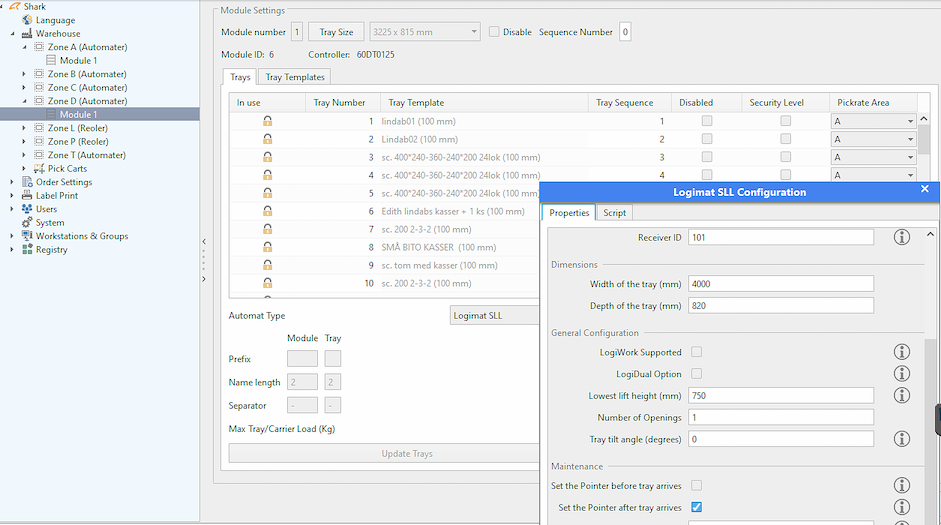
Easy configuration of Vertical Lifts
Pick-by-light
Pick-by-light: Support for pick-by-light systems from KBS.
